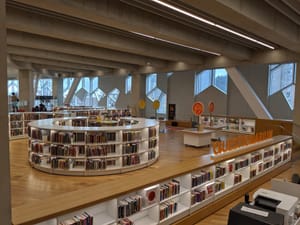Increasingly we need to think about library services in the context of the full web of user experience. This is easy to say, but it is rather more difficult to tease out what it means. One way to think about it is to think about some of the characteristics of the major web presences which have become the first — and sometimes last — resort of research for many of our users. And then to think about library services within that context. This may not provide very many answers, but it does give us some good questions!
This post is prompted by the current discussion of user interfaces on lita-l and web4lib. Making our interfaces more like Google, Yahoo! or Amazon may or may not be sensible, but it is a small part only of the rather bigger issue. Which is that however good the catalog interface is, it may be unseen by many library users because they spend most of their time elsewhere.
Here is one view of important characteristics of these services. It is followed by some consideration of library services
- A comprehensive discovery experience. For many users, Amazon, Google or Yahoo! represent the universe of available resources. The user of Google or Yahoo! feels they have prospected the available web. The user of Amazon feels that they have prospected the available book resource. They may know that this is really not the case, but, given available tools, the transaction cost of looking further is often too high. These are one-shot discovery experiences for the user: they have sufficient scale for the user to be assured that they have been exhaustive. This scale means that they present very large information spaces, spaces in which any boundary walls are very far away, maybe even invisible.
- Predictable, often immediate, fulfilment. Once the existence of an item is discovered, these services offer fulfilment services. The simplest is where discovery, location and fulfilment are concatenated into a simple click of a URL and the resource is returned as a web page. More complex is where a user opts to buy a resource from Amazon. Once bought, it is possible to track the status of the transaction at any stage. In more complex scenarios, the service may help you locate a provider of an instance of the discovered resource, and fulfilment services on that instance. So Google may offer several fulfilment options within Google Print: go to publisher, to Amazon, or to a used book store for example. Amazon may offer several sources for fulfilment. In each case, there is a focus on the complete chain – discovery, location, fulfilment – and a concern to efficiently manage the user experience up to satisfactory fulfilment. Indeed, it is interesting to see the current emphasis on access to resolver data by Google Scholar. This is important as successful fulfilment is central to the Google experience: they want to avoid ‘dead-ending’ the user.
- Open to consumers. This is a clumsy expression for an important concept. These services recognize that they are a part of the web experience of their end-users, and are keen to be woven into the fabric of their web experience. They are immediately accessible on the web. They are densely interconnected internally, allowing the user to traverse data within the service in much the way that they are used to traversing the web. They work the data they have hard, allowing you to use any piece of data as a springboard to other resources. They also provide mechanisms for user to move between services. Think of URLs for a moment: these are central to the fabric of the web and our experience of it. Amazon has become a de-facto source of sharable book details, because you can use an Amazon URL as a ‘handle’. If somebody wants to send somebody else a reference to a book, it is very easy to send them an Amazon URL. Google or Yahoo! let you share a results set as a URL. One of the nice features about the new Google Maps service is that you can drag the area you are interested in into your window and then capture a URL for that particular view.
- Open to intermediate consumers. Amazon, Google, Yahoo!, eBay, and now the BBC: they all recognise that they are not the ultimate destination for all web users. They recognize the value of other services. However, they also recognize the value of making their own data and services available in such a way that they can be surfaced and reused by intermediate consumers, who mix them into new offererings to users. See for example the use of Amazon data in LivePlasma: in this case, LivePlasma is an intermediate consumer of Amazon’s data, remixing it within their own application for presentation to the user. Through toolbars, RSS feeds and web services these services are potentially woven into multiple destinations and user experiences. They want to make it as easy as possible to make their services available at the point of need.
- A co-created experience. Many large Internet presences involve the user in the creation of the service or in their own experience of it. Each is leveraging a growing amount of data to create additional value. This may be user contributed data, as with Amazon reviews or eBay ratings, or data that is collected by the services about resources and about user behaviors and preferences. Think of how Google and Amazon reflexively use data to modify the service, whether in personalization features, page ranking, or targeted advertizing. They may lack highly structured data but they sure make what data they have work very hard.
Given these characteristics, these services exercise great gravitational pull on users. They do this because they have scale, and because they give the user a sense of control. So, let’s turn to library resources and think about them under the same headings.
- A comprehensive discovery experience. The library discovery resource is fragmented. It may not be clear to an individual user which database to look at, what part of the universe they are prospecting in any individual database, or when they have ‘finished’ a search. The division of the library resource into the catalog, lists of electronic resources, and other databases may be confusing. These characteristics reduce the user sense of control and increase transaction costs. It is not always clear what part of the information space you are in, or it may seem like a rather limited information space: you bump into the walls. This is the area into which metasearch is stepping as a solution. However, it faces many challenges which prompted me to wonder in another post whether we should also be exploring much greater consolidation of library resources for discovery purposes.
- Predictable, often immediate, fulfilment. Items in the catalog may be immedately available, or it may be possible to put in a reserve. Libraries are currently putting in place a variety of systems to manage the discovery (metasearch, lists of e-journals and databases, ..), location (resolution) and fulfilment services. In fact, much of the activity in this space is really about streamlining the supply chain between the user and the resource so that it disappears from view, thereby reducing the user’s transaction costs in using this material. Where an item is not available, then various resource sharing options may be available. The quality of service offered to the user may be variable depending on how much of the intermediate processes are hidden from them, and how much information is available to them about the status of any particular request. So, what we have here is a discovery-location-fulfilment chain which is variably automated, which may still be fragmented by type of resource (book, licensed, …), and which varies quite a bit in quality of service across institutions.
- Open to consumers. Most of our information systems are rather closed. They do not all offer the ability to link with persistent URLs. Many may offer few internal navigation options. The user experience in moving between them is one of moving from one environment to a very different one, where one may have to adjust to very different interaction behaviors, re-do searches, separately save results, and so on. They are often designed as if they were the sole focus of a user’s attention, with special functions, help screens and other features which are rarely used. A major focus of interesting work reported by Dan Chudnov and colleagues in several places is to improve the ability of users to move across library resources in ways in which they are used to from their experiences with more open web environments.
- Open to the intermediate consumer. Library systems tend to be also closed from a te
chnical point of view. RSS feeds, web service interfaces, flexible data export: it may not be straightforward exposing their services to intermediate consumers like course management systems or campus portals. This becomes a major issue as it is vital for libraries to place their services at the point of need within the user workflow: their services must be provided so that they can be recombined with other service environments much more effectively. So, we may want a search box for the library catalog to be visible within several non-library environments. - A co-created experience. Our systems are not very engaging in this way: we not make great use of contributed data, nor do we adapt reflexively in light of user behavior or usage data. Our systems are rather inert.
So, unlike the major online presences, our systems have low gravitational pull, they do not put the user in control, they do not adapt reflexively based on user behavior, they do not participate fully in the network experience of their users.
The more I think about these isues, the more I think that a major question for us moving forward is organizational. What are the organizational frameworks through which we can mobilize collective resources to meet the challenges of the current environment? How do we overcome fragmentation; streamline supply; reduce the cost of the system and service development which is incurred redundantly across many institutions.
Some related entries:



